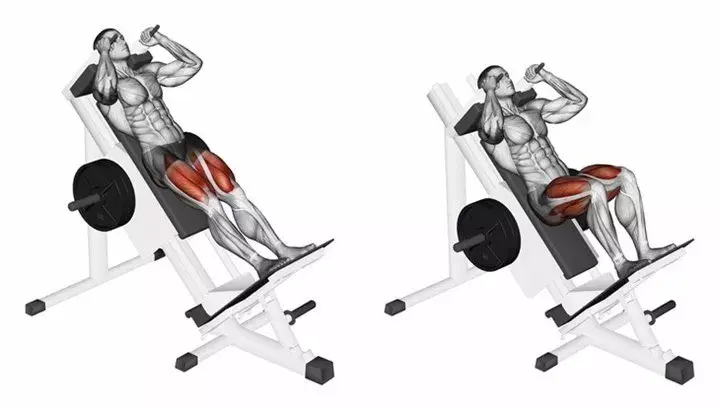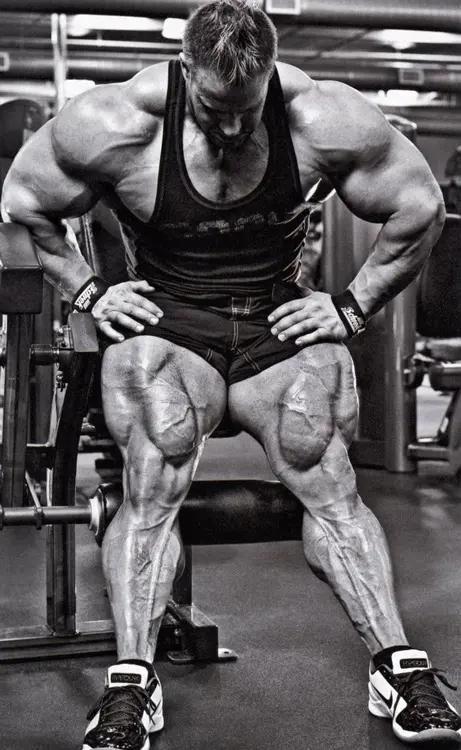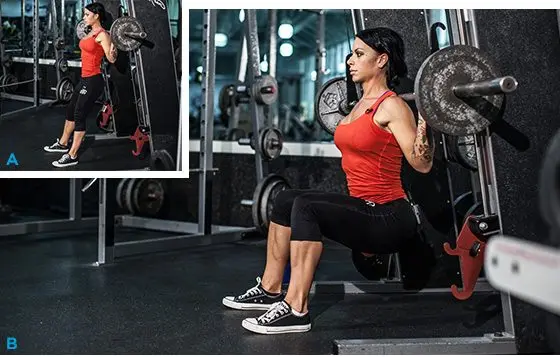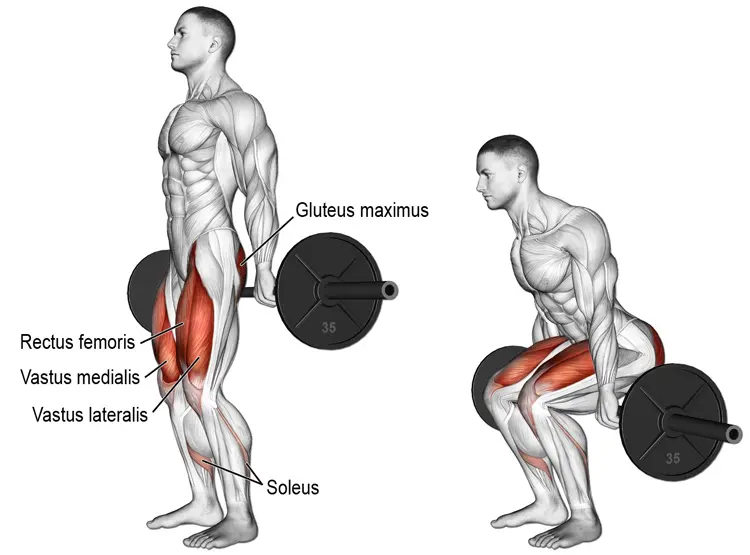The hack squat is a lower body exercise targeting the quadriceps, glutes, and hamstrings. It’s performed using a hack squat machine, offering a safer, more controlled squat variation than traditional free weights.
I have been using the hack squat machine in my leg workouts for over 10 years, and it has helped transform my quads from a weakness into a strength.
As a personal trainer, I program the machine hack squat in beginner workout routines, especially for those hesitant about squatting with a barbell on their shoulders.
Here’s some detailed information about this functional movement, with exercise instructions and some neat variations:
How To Perform Hack Squats
Here are the step-by-step instructions to perform the hack squats with a picture-perfect form:
Step One — Take Your Position
Adjust the machine so the shoulder pads are in a comfortable position. Place your feet against the machine’s back pad. Maintain your spine’s natural curvature throughout the exercise. Your upper and lower back and hips should be in contact with the back pad.
Level Up Your Fitness: Join our 💪 strong community in Fitness Volt Newsletter. Get daily inspiration, expert-backed workouts, nutrition tips, the latest in strength sports, and the support you need to reach your goals. Subscribe for free!
Hold the machine’s handles in a comfortable position with a neutral grip. Position your feet hip-width apart higher up on the platform. Turn out your feet slightly and ensure your knees align with your toes.
Pro Tip: Your exact foot placement on the angled foot platform will depend on your height and body mechanics. Taller individuals usually find placing their feet higher on the platform more comfortable than their shorter counterparts.
Step Two — Lower Into a Squat
Take a deep breath into your belly and hold it as you slowly lower into a squat by flexing your hips, knees, and ankles. Keep your back and glutes glued to the back pad throughout the range of motion.
Go down as far as your mobility allows. Your upper and lower legs should be at a right angle at the bottom. Maintain a neutral spine and head position and look straight ahead during the lowering motion.
Pro Tip: I recommend my clients wear a weightlifting belt during this exercise. It helps keep your core stable and generate thoracic pressure, allowing you to lift heavier weights safely.
Step Three — Concentrics
Breathe out sharply and extend your knees, ankles, and hips while pushing through your whole feet to return to the starting position.
Pause and contract your quads and glutes at the isometric contraction point.
Repeat for recommended reps.
Pro Tip: Many people lift their lower back off the back pad to generate momentum when in the hole. Doing so can put unnecessary strain on your lower back and increase your injury risk. Limit the movement to the quads and glutes.
Hack Squat Tips:
- Never arch or round your back, as this can cause pain and injury.
- Use a weight that will not compromise form.
- Focus on establishing a mind-muscle connection for optimal target muscle stimulation.
- People dealing with lower body joint issues should avoid letting their knees extend over their toes on eccentrics.
- Start off light and gradually increase your working weights as you become stronger.
- Warm up with a few sets of 40 to 60 percent of your one-rep max before training heavy to reduce injury risk.
Programming Hack Squat (Sets and Reps)
How you program the hack squat into your workout regimen will depend on your current fitness level and your training objective.
Here are the optimal rep and set ranges for targeting strength and muscle mass gains:
Muscle Mass
Though versatile for any training regimen, the hack squat is particularly favored in bodybuilding for its effectiveness in muscle gains, making it a staple in their workouts.
Perform three to five sets of 8 to 12 repetitions with 60 to 80 percent of your one-rep max (1RM) for optimal hypertrophic gains. (1)
Beginners should start with three sets, while more advanced trainers can shoot for five sets of hack squats per workout.
Strength Gains
Since the hack squat machine has a fixed movement trajectory, it reduces the reliance on core stabilizers. Powerlifters usually perform the hack squat as an accessory lift in their workouts.
Three to six sets of 1 to 5 repetitions with 80 to 100 percent of your 1RM optimizes strength gains.
Remember, going too heavy and compromising your form can significantly increase your injury risk. Focus on drilling the movement mechanics before you start lifting big on this exercise.
Endurance
I’d advocate for more hack squat inclusion in endurance training programs. Endurance training involves performing a high number of sets and reps in a short period to bias muscular endurance and overall stamina.
The hack squat machine offers a safe setup for endurance athletes to perform their high-volume workouts. Plus, the hack squat machine’s minimal setup makes it ideal for HIIT workouts, allowing for seamless transitions between exercises.
Endurance athletes must perform 1-3 sets of 15 or more repetitions with loads below 60 percent of their 1RM for favorable results.
Finding the right number of sets and reps to get the best results can take trial and error. Start with lower sets and reps and lighter poundage and progressively increase the volume and intensity. Master the exercise form before you go hard and heavy on this exercise.
Utilize the hack squat along with your conventional squats, deadlifts, lunges, or any other leg exercises. The hack squat can be used as a significant mass and strength builder.
Hack Squat Target Muscles
The hack squat is a compound movement that works all lower-body muscles (quadriceps, hamstrings, glutes, calves, and hip flexors) and the core muscles; which include the rectus abdominis and internal/external obliques. Here is a brief overview of each of these exercises:

Quadriceps
The quadriceps, popularly known as the quads, are at the forefront of this and almost every other squat exercise. They consist of four primary muscles – the vastus medialis, lateralis, intermedius, and the rectus femoris.
The vastus medialis, known for its teardrop shape, stabilizes the patella and knee joint during the lift; the vastus lateralis, the largest of the quad muscles, aids in extending the knee. On the other hand, the vastus intermedius supports knee extension during the hack squat, and the rectus femoris works to raise the thigh.
Hamstrings
While the quads are the stars, the hamstrings are the essential supporting cast. These muscles, located at the back of the thigh, balance the force of the quads, aiding in knee and hip stability during the lift.
A well-executed hack squat ensures the hamstrings are engaged, although not as primary movers.
Pro Tip: Place your feet high on the foot platform for greater hamstring engagement. Conversely, place them lower to limit hamstring engagement.
Calves
The calves, comprising the gastrocnemius and soleus muscles, might seem like minor players in the hack squat. However, they provide crucial ankle stability and assist in the pushing phase of the lift.
Strong calves contribute to the overall power and stability required for a successful hack squat. Many beginners experience shaky calves during a relatively heavy hack squat.
If your legs start trembling during a hack squat and your heels come off the platform, it is a sign that you should lower the weight.
Core
The core, comprising the rectus abdominis, obliques, and the deeper muscles, like the transverse abdominis, acts as a stabilizing force. During a hack squat, your core muscles spring into action, creating a robust central column.
This stability is vital for maintaining an upright posture and ensuring the spine is well-supported throughout the movement.
During eccentrics, the core muscles contract isometrically to resist the downward force of the weights, safeguarding the lower back. This contraction is subtle yet powerful, preventing any unwanted forward lean or rounding of the back, which could lead to injury.
Conversely, during concentrics, the core provides this stabilizing force, ensuring the lift is smooth and the body remains aligned.
Hack Squat Benefits
The squat is a beneficial exercise in general because it’s a lower-body strength and mass builder.

Muscle Mass
You can build as much muscle with the hack squat as you can with the barbell back squat, although trunk activation is not as prominent which we’ll explain further. But if you’re using a challenging weight while continuing to implement progressive overload, you’ll still activate the trunk muscles to an extent.
Now, athletes can use the hack squat for lower body development as well. But it’s not the best option if training for functional performance since this variation does not require as many stabilizer muscles. Moderation is important and using a combination of free weight and machines is ideal.
Increased Strength
Again, the hack squat will increase lower body and posterior chain strength. You have the ability to lift maximal loads due to not having to stabilize the weight. Just be sure to incorporate some free weight stability training as well to improve functional strength and develop stabilizer muscles of the legs too.
Minimal Lower Back Strain
The hack squat is also beneficial because the weight load is distributed through your center of mass at an angle. This alleviates stress on the spine and allows more weight to be lifted overall.
Common Mistakes During Hack Squat and How To Avoid Them
As a veteran personal trainer, I’ve witnessed every possible mistake people make when performing the hack squat. Here are some of the most common ones and how to avoid them to maximize results and minimize injury risk:
1. Improper Foot Placement
Incorrect foot placement is among the most common hack squat mistakes. Placing your feet too close can place undue stress on the knees, while too wide a stance can shift the focus away from the quadriceps.
I’ve also seen people trying to load the quads place their feet high on the platform. However, it shifts the focus to the hamstrings and glutes.
How To Avoid: Position your feet shoulder-width apart with toes slightly pointed out in the middle of the foot platform to get the best of all worlds. This stance offers a balance of quad engagement and knee safety.
2. Inadequate Depth
Many athletes cut the squat short, not reaching the depth necessary to engage the target muscles fully. A shallow squat limits the activation of the glutes and hamstrings.
Level Up Your Fitness: Join our 💪 strong community in Fitness Volt Newsletter. Get daily inspiration, expert-backed workouts, nutrition tips, the latest in strength sports, and the support you need to reach your goals. Subscribe for free!
One of the biggest reasons hack squats are such a hit is because they allow you to achieve greater depth (read: more muscle stimulation) without having to worry about stabilizing the weight.
Limiting the range of motion defeats the entire purpose of the hack squat.
How To Avoid: Aim to lower your body until your thighs are at least parallel to the floor, ensuring deeper muscle engagement. Remember, depth should be achieved without compromising form. Avoid rounding your back on eccentrics.
3. Excessive Forward Lean
Leaning too far forward during the movement can strain the lower back and shift the load away from the legs.
I’ve seen people place their shoulders near the front edge of the shoulder pads to achieve greater depth.
While this might allow you to achieve a deeper squat, this places undue stress on the lower back, which skyrockets your chances of getting hurt.
How To Avoid: Keep your back against the pad and maintain a straight posture throughout the exercise. This alignment ensures that your legs, not your back, bear the brunt of the work.
4. Overloading the Machine
Many people let their egos get the better of them on the hack squat.
Folks who cannot perform a single rep of the conventional barbell back squat with one plate load two plates on the hack squat machine to compensate for their lack of strength.
Adding more weights than you can handle safely can lead to form breakdown and increased injury risk.
How To Avoid: Start with a weight that allows you to perform the exercise with proper form. Gradually increase the load as your strength improves.
5. Rapid Movements
Using a slow rep cadence can be incredibly effective for boosting the target muscle engagement.
If you find yourself rushing through the reps, it’s probably because the weight on the machine is too much.
How To Avoid: Reduce the weight and use slow and controlled eccentrics and concentrics to make the most of this exercise. Execute the movement with a controlled tempo, focusing on muscle contraction and stability. A slower descent and ascent will enhance muscle activation and development.
6. Neglecting Core Engagement
Failing to engage the core can result in a lack of stability during the exercise.
The back coming off the back pad is one of the most common signs of a lack of core engagement.
How To Avoid: Actively engage your core throughout the movement to maintain balance and protect your spine. I recommend wearing a weightlifting belt during the hack squat. It gives you something to brace against and significantly boosts your performance.
7. Ignoring Pain or Discomfort
Pushing through pain can exacerbate existing issues and lead to serious injury.
No pain, no gain is one of the most toxic phrases in strength sports.
Most people have no idea how to differentiate lactic acid build-up with muscle and joint pain or discomfort.
How To Avoid: Listen to your body and differentiate between muscle fatigue and pain. If you experience discomfort, especially in the knees or back, assess and adjust your form or consult a fitness professional.
8. Inconsistent Breathing
Holding your breath or breathing inconsistently can lead to a lack of oxygenation and stability.
Short and frequent breaths are some of the best ways to hamper your performance. You’ll be so busy breathing that you’ll forget about muscle contractions.
How To Avoid: Maintain a consistent breathing pattern by breathing in and holding your breath on the descent and exhaling on the ascent.
Origin of Hack Squat
The hack squat is the namesake of the Estonian wrestler, strongman, and strength sports pioneer George Hackenschmidt (1878-1968). Hackenschmidt was the first-ever World Heavyweight Champion in professional wrestling, earning him the moniker ‘The Russian Lion.’
As you would have probably guessed, Hackenschmidt didn’t invent the hack squat machine back in the day. Instead, he performed the hack squat while holding a barbell behind his legs with his arms fully extended.
A barbell hack squat looks more like a behind-the-body deadlift than a squat. However, the movement mechanics load the quads and glutes.
While the barbell hack squats have taken a back seat, machine hack squats are a staple in most leg training routines.
Machine hack squats are an incredibly effective exercise to bias the quads and glutes. Since the machine moves on a fixed sled, it removes the need to balance the weight, allowing you to focus on the target muscles.
Hack Squat vs. Barbell Back Squat
The hack squat machine eliminates stability issues, and its angled design focuses on the quads, minimizing lower back strain and ensuring a safer and more targeted leg workout.
It is an excellent exercise for novice lifters to build confidence in their squatting ability.
The hack squat is much different than the conventional free-weight barbell squat. Both movements target the same primary muscle groups, and the strength benefits are very similar. However, it’s beneficial to know what differentiates the two and how to incorporate the hack squat in your training regime.
The hack squat is generally safe to perform for most people, and it’s unique in that you’re at an angle during the movement. There are benefits to this, which we’ll discuss, but it’s hard to go wrong with the hack squat as it’s a viable alternative to the barbell squat.
The hack squat (HS) differs from the barbell back (BS) squat in many ways. According to studies, the barbell squat elicits greater trunk activation than the hack squat. That’s because the trunk is highly supported at an angle against a backrest. (2)
So, the back squat is actually better for trunk development and core stability. This is ideal for athletes, which means free weights are preferred overall due to better stabilizer muscle development/maintenance.
But that doesn’t mean you should neglect the hack squat, as it’s still a powerful exercise for building those wheels. Both variations will elicit similar results for pure strength and hypertrophy overall.
Hack Squat Variations
Some fitness centers do not have a hack squat machine. But no worries, there are some variations you can do to mimic the movement and they’re very effective.
Smith Machine Hack Squat

The Smith machine is one of the most useful pieces of equipment available. You can work every muscle in multiple ways, and you don’t need to worry about stabilizing weight.
- Set up the bar so that you’re comfortably beneath it, similar to a barbell back squat.
- Angle yourself, similar to the hack machine, by stepping out and keeping your feet flat on the floor. You should be leaning back against the bar.
- Squat down to parallel or slightly below.
- Then push up through your heels and repeat for repetitions.
Pro Tip: Place a quarter plate under each foot to increase the starting dorsiflexion and improve your mobility to achieve a better squat depth.
Barbell Hack Squat
The barbell hack squat is a free-weight alternative if you don’t have access to a hack squat machine or even if you just want to switch things up a bit.

It actually more closely resembles a deadlift since you’re lifting from the floor, but it’s very effective nonetheless.
Start with the loaded barbell on the floor and face away from it with your Achilles touching the bar.
- With your back straight, bend down and grip the barbell with arms slightly wider than shoulder-width distance apart.
- Squat the weight up through your heels and thrust your hips forward as you pull. This will allow the weight to move smoothly up your posterior chain.
- Return the weight back to the floor but keep your core tight and immediately repeat the movement.
Pro Tip: Practice this exercise with a light weight until you drill the movement mechanics.
Reverse Hack Squat
This variation shifts the focus to the glutes and hamstrings instead of the quads. You’ll face the machine, leaning your chest against the pad instead of your back. It’s excellent for those looking to engage the posterior chain more prominently.
- Position yourself under the shoulder pads close to where they attach to the back pad.
- Place your feet slightly wider than shoulder-width apart in the center of the platform.
- Push your hips back and down to lower into a squat until your upper and lower legs are at 90 degrees.
- Explode back to the starting position.
- Repeat for recommended reps.
Pro Tip: Push your knees outward during eccentrics to lower your hips between your feet. This will reduce the strain on your lower back.
Hack Squat Alternatives
Here are some of the most potent hack stack alternatives to add to your exercise arsenal:
Barbell Front Squat
The barbell front squat is a superb alternative that mimics the quad-dominant nature of the hack squat. It also doesn’t strain the lower back as much as the conventional barbell back squat.
- Rack a barbell in a squat rack at an appropriate height.
- Place your feet directly under the barbell and place it in the front rack position.
- Unrack the bar and step back.
- While keeping your torso upright, lower toward the floor until your upper and lower legs are at 90 degrees.
- Return to the start position.
Pro Tip: I recommend that you use the ‘clean’ front rack grip instead of the bodybuilder-style cross-arm grip. The weightlifting-style grip is better at ensuring the bar stays in place during eccentrics.
Leg Press
The leg press is an excellent hack squat alternative with similar strength, muscle, and endurance benefits. Per your biomechanics, you must find the proper foot placement on the leg press platform to maximize this exercise’s results.
- Place your back on the hack squat machine’s back squat. Maintain your spine’s natural curvature.
- Position your feet hip-width apart on the foot platform close to the bottom.
- Ensure that your knees align with your toes.
- Take a deep breath and slowly flex your knees.
- Bring the weights as low as your mobility allows.
- Pause for a second in the hole.
- Explode back to the starting position.
Pro Tip: Wearing weightlifting shoes while performing the leg press can be an absolute game changer. The raised heels can boost your range of motion, resulting in greater muscle engagement — and growth.
FAQs
What muscles does the hack squat work?
The hack squat works the muscles of the lower body including the legs, hip flexors, and even the core muscles.
Is the hack squat an effective lower body exercise?
Absolutely! You can build big, strong legs using the hack squat machine as you can really load up the weight and challenge your lower body.
Is there an advantage of the hack squat over the conventional barbell squat?
As a matter of fact, there is. The hack squat allows you to focus more on the actually exercise rather than having to stabilize the weight which you’d need to do with the conventional barbell squat.
It may also be a safer way to lift maximum poundages.
Is the hack squat one of the best leg exercises?
It’s a very effective leg exercise and there’s no reason to not include in your lower body mass and strength-building routine.
Because you’re locked in during the movement, you don’t have to use your stabilizer muscles, therefore, you may be able to lift more weight overall which is a huge benefit.
Final Thoughts
The hack squat is a beneficial exercise you should consider adding to your leg day. It’s effective for building muscle and strength; plus, you don’t need to balance a barbell on your traps; which is appealing for many.
However, it’s no substitute for free weight training but it’s a viable option. And if your gym doesn’t have a hack squat machine you can always do one of the variations/alternatives above to get similar results.
So, try out the hack squat and experience for yourself just how functional it really is!
References
- Schoenfeld BJ, Grgic J, Van Every DW, Plotkin DL. Loading Recommendations for Muscle Strength, Hypertrophy, and Local Endurance: A Re-Examination of the Repetition Continuum. Sports (Basel). 2021;9(2):32. Published 2021 Feb 22. doi:10.3390/sports9020032
- Clark DR, Lambert MI, Hunter AM. Trunk Muscle Activation in the Back and Hack Squat at the Same Relative Loads. J Strength Cond Res. 2019 Jul;33 Suppl 1:S60-S69. doi: 10.1519/JSC.0000000000002144. PMID: 28704312.









I’ve been searching for a place like this for
a very long time. I was looking for somebody who’d be able to clearly browse me with this
matter and was fortunate enough to locate you.
Thanks a lot for the detailed reason, you drew attention to an extremely common matter!
Although I share your view for the most part, I presume that a few factors are worth having a more detailed
look to understand what is going on.